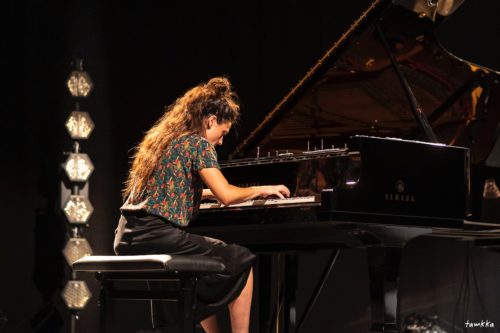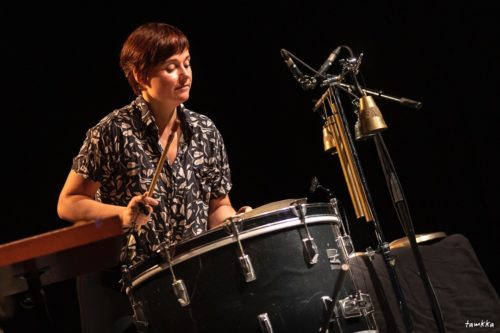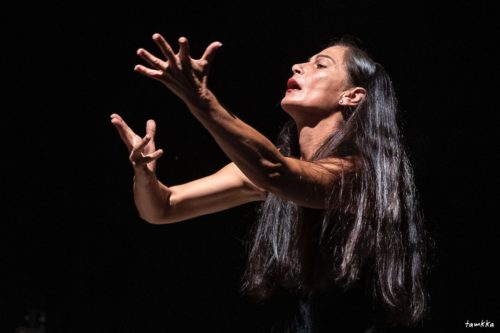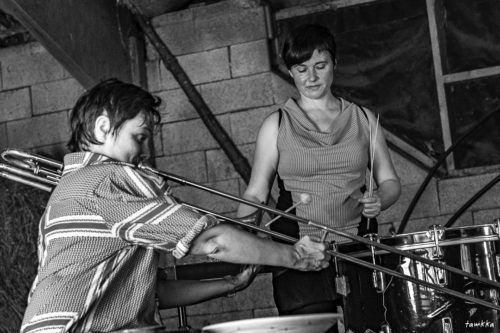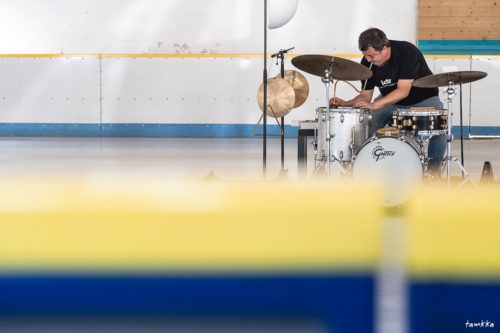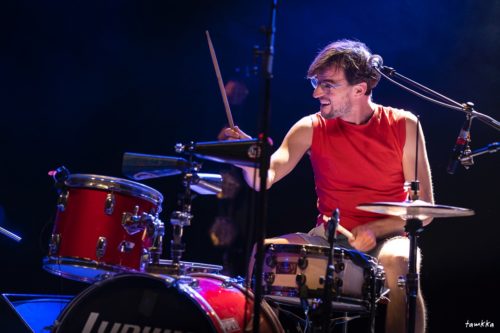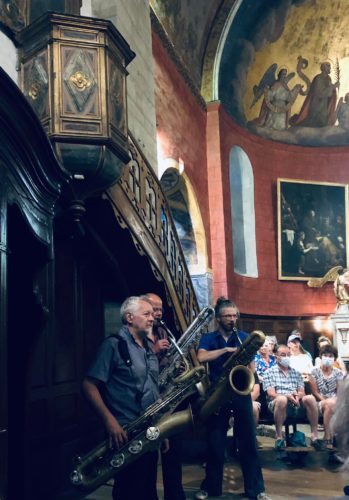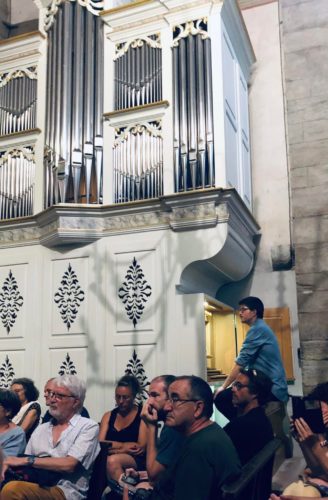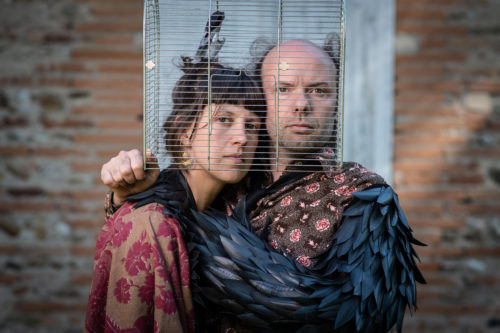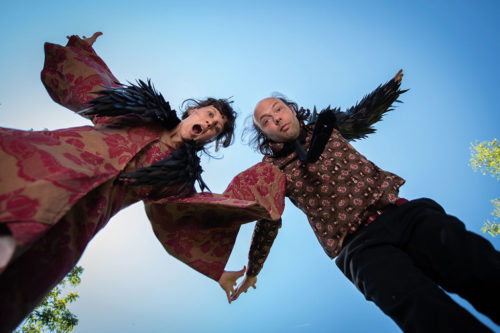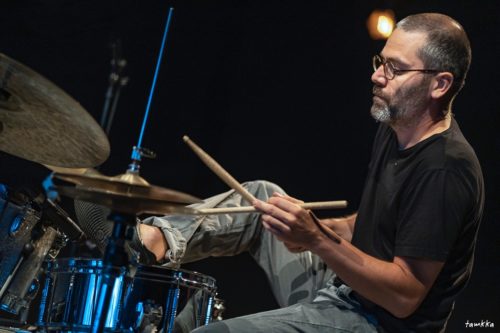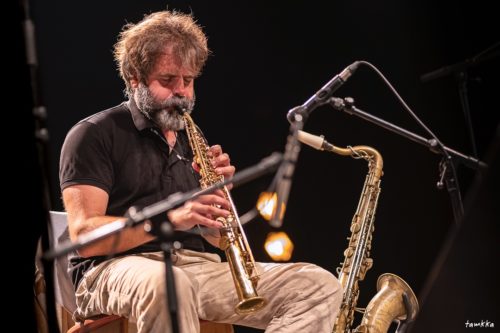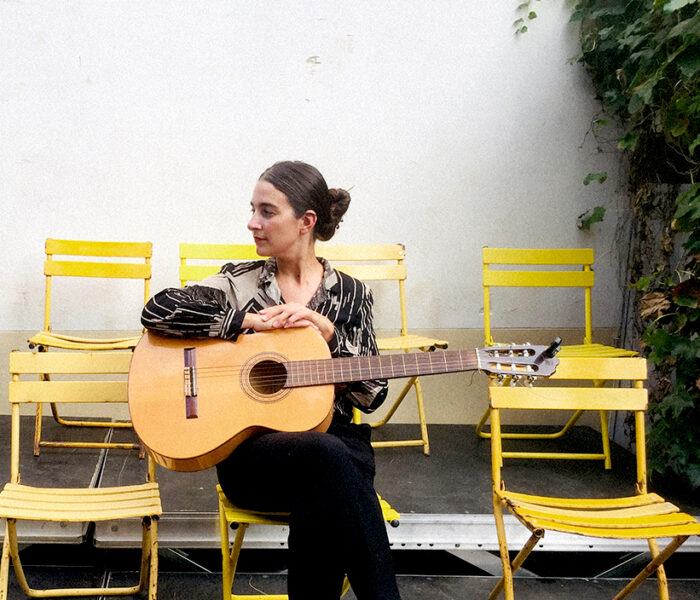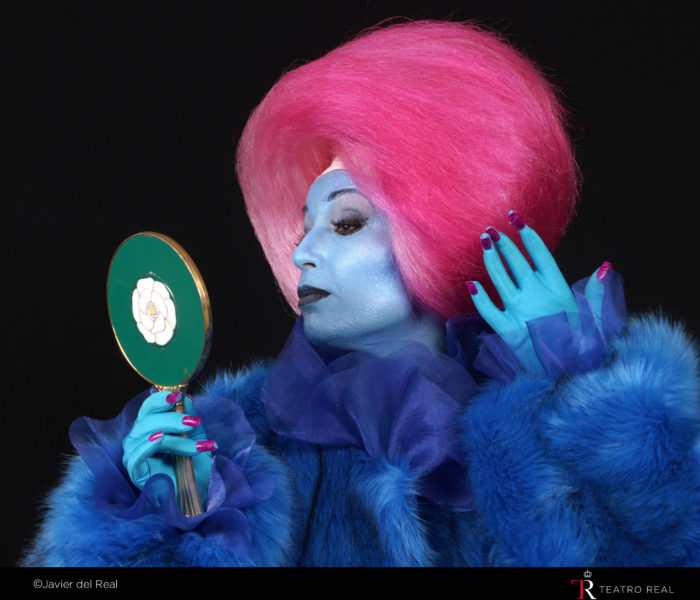Four red threads have been woven into the 31st edition of the Jazz à Luz festival from July 13 to 16. Focus on Barcelona's young improvised music scene, reunion with singer and violinist Iva Bittova, discovery of young talent, and support for regional creation through a creative residency. As a cultural player, Jazz à Luz also wanted to make its contribution to greater gender equality in jazz and improvised music.
A tribute to women on the first day of the festival with "Tôle Story", a street show by Compagnie d'Elles, followed by a Franco-Catalan trio's tribute to Mexican singer Chavela Vargas.
Trio of Nuria Andorra, Jordina Milla, Sonia Sanchez
Big top, July 13
A wonderful discovery, this Catalan trio from Barcelona, with its play on color and timbre.
As for color, the eye is immediately drawn to the red shoes of the dancer in the foreground, dressed entirely in black. Sonia Sanchez moves on wooden floors, one "à cour", the other "à jardin". Her dance could be described as stylized, if you compare it to the flamenco from which it originated. Body movements are sober and sparing, except for those of the feet, shod in flamboyant red heels. If there's any expressiveness to be found in the dancer's angular body and closed face, it's to be found in her hands. Sonia Sanchez has studied Butô dance and combines it wonderfully with her already rich palette, a subtle blend of contemporary dance and flamenco. Her body, alternately dancer and puppet, draws broken lines in space, and willingly takes on a jerky aspect.
Sonia Sanchez interacts with pianist pianist Jordina Milla and percussionist Nuria Andorra not through her gaze (she seems walled in) but through the sound of her steps, the pounding of her red heels. There's a kind of pent-up violence in her dance.
The musicians don't look at the dancer. The clatter of her steps is their score. Beneath these steps, they unroll a carpet of sound, made up of rubbing, blowing, rustling wings and constantly evolving textures.
The atmosphere is twilight.
At times, a mimicry seems to link the pianist's playing to Sonia Sanchez's heels, at other times it's Nuria Andorra's percussion that strikes in unison with the dancer's heels, whose body is sometimes drawn into a gallop, and becomes animal!
Halfway through the concert, Sonia Sanchez leaves the two wooden floors and moves to the middle of the stage; she leans forward and brings her hand to her mouth: a beautiful moment of pure poetry, almost like a painting! Then she draws the movements of a bird in space, before being swept away by the storm of sound. The storm roars. The volcano is erupting. A volley of bells can be heard.
After the storm, the dancer curls up in the piano, like a wounded bird.
The following day, a few kilometers from Luz, near Gèdres (Bergerie du hameau d'Ayrues), percussionist Nuria Andorra is back, this time in a duo with trombonist Christiane Bopp. In the thick, almost stifling warmth of the straw-bale barn, the musicians gradually "find each other" and sculpt the saturated space together. They share moments of double percussion playing on creations by the farmer, who is also a ceramist. The trombonist blows and strikes at the same time! The large audience - too many in such a small space - holds its breath to take in this delicate duet, which is not helped by the acoustics, but which moves forward, driven by a love of sound.
On the way down from the hamlet, we arrive in Gèdre, a small town with a swimming pool and ice rink. Barcelona-based percussionist Vasco Trilla is waiting for us. We're well aware of the adaptability of the Jazz à Luz audience. A concert in an ice rink? Unheard of! However, the audience, confident and amused at the same time, soon settled down in a ring around the oval ice rink, and opened the hatches!
Vasco Trilla, solo
Gèdre skating rink, July 14
Vasco Trilla enters the ice ring like a bullfighter in the arena, through a small door. His percussion set is placed in the middle of the ice. It's an alloy of skins (tom and snare drum), metals (gilded plates suspended from a gantry, cymbals, gongs), and lots of objects (small colored cups, tubes, drumsticks, large sanza...)
The musician calmly and confidently deploys several layers of sound, superimposing sounds and textures. He succeeds in making us forget his solitude.
Improvisation unfolds as if "on the edge of ice". Vasco Trilla's solo happily avoids the catalog of sounds that sometimes characterizes some improvisational solos. The ear is drawn into a journey, a dramaturgy.
Vasco Trilla subtly alternates held sounds and micro-events, resonances and dry sounds. A forest of metronomes placed on the floor all around the musician forms a sound carpet, a continuum on which the percussionist improvises. At times, you have the feeling of being plunged into the heart of an improvised "gamelan".
It's as if the ice (in contrast to the straw bales in the sheepfold) "conducts" the sounds, allowing them to blossom, offering them the ideal space.
We emerge from this solo refreshed and invigorated by so much finesse!
Jazz à Luz 2022 creation: Tust, with the Cocanha duo and the Sec duo
Chapiteau, July 14
Jazz à Luz put young musicians in the spotlight at this 31st edition, with two groups in residence: Cocanha and Sec. The result of this carte blanche is Tust, and Tust "is the strike, the blow, the gentle collision of Cocanha and Sec".
Tust's residency led to the birth of a new repertoire that seals the alliance of two sonic approaches: traditional Occitan music (polyphonic "dance" songs) and alternative rock.
Tust blends the sounds of four voices, three string tambourines, two basses, a drum kit and "hearts beating in unison".
With their radiant, timbred voices, the two singers Lila Fraysse and Caroline Dufau succeed in drawing the two boys from Sec, Jules Ribis and Xavier Tabard, into their territory: that of Occitan song. It's a fine testament to the feminine persuasiveness of these two singers, who have also managed another tour de force since they began working in the Occitan polyphonic repertoire, that of stripping song texts of their misogynistic connotations.
The quartet varies the pleasures and colors, moving from a cappella to accompanied singing. The melodies are simple and straightforward, the carrures assertive. The sound is beautiful and full. We move from Brigitte Fontaine's "Vous et nous" to a Reunionese song in Creole, to the song of the Pillards, to that of the Donzelles...
Tust has a promising future and solar energy!
Tubi Nebulosi: Giulio Tosti meets No Noise, No Reduction (Toulouse-based bass sax trio)
Église des Templiers, July 15
Jazz à Luz concerts at the Eglise des Templiers are rare. The one held on July 15 was one to remember, and one that won over the large audience. It was undoubtedly the magic moment of this year's edition!
On the menu for this morning concert was a one-breath improvisation (and what a breath!) offered by a quartet brought together by Toulouse-based Freddy Morezon. The three saxophonists of " No Noise, no reduction " - Marc Démereau, Marc Maffiolo and Florian Nastorg - were joined by the young Italian organist Giulio Tosti.
The very first meeting took place in September 2021 on the initiative of the "Toulouse Les Orgues" festival. More precisely, it was the Italian organist who, as a passionate improviser, had expressed the wish to meet Toulouse improvisers for a series of impromptus.
A year later, the quartet met again in the Templiers de Luz church, with its frescoes and painted dome, its small mechanical organ nestling in a white wooden case. The organ has the dimensions of a Baroque organ: barely twenty stops. The light-wood drawers and two manuals are clearly visible.
The three blowers stand to the left of the organist, under the priest's pulpit. Each of us can see the organist in action: we're sitting right next to the organ case! One festival-goer even leans against the organ case to feel its vibrations...
What's striking about Giulio Tosti's playing is the way he "holds" the pulls, making the organ "cry" or moan. The musician deploys a number of non-academic playing modes: clusters, micro-intervals, chords with the flat of the hand, "à la Monk"! His playing is very raw and organic. He often uses the keyboard as if he were playing a percussion instrument: abundant tremolos on the keyboard, with the flat of the hand.
Improvisation plays on the opposition between bass and treble, between held and rhythmic sounds, lyrical flights and a stripped-down universe. The sounds emanating from the pipes (those of the low, baritone and bass saxophones, and those of the organ) give the impression of being those produced by animals. You could be at the bottom of the ocean, in the presence of a kraken or a whale, so organic is the music.
What you feel vibrating deep inside you is the pulsation of a large animal... The improvisation is powerful, unfolding as the musicians respond to each other. At times, you think you hear cries or bird calls.
The musicians conclude their improvisation with a surge of sound, an almost Dionysian tumult! After this long plunge into the bass of the instruments, the musicians choose the treble to let their cries burst forth.
The very last sound is played by the organist in the treble of the instrument: a heart-rending sound, held for a very long time. On the dome, an artist long ago painted a Christ with two fingers raised, surrounded by angels. I'm sure his brushes would have quivered at this music!
Duo Krci (Emilie Skrijelj, Loris Binot) and Lê Quan Ninh
Maison de la vallée, July 15
Three generations of musicians come together on the stage of the Maison de la Vallée in Luz, sharing the same passion for sound research and everything that takes place between the birth of a sound and silence. Accordionist accordionist Emilie Skrijelj had carte blanche for two concerts on this 31st edition, the first with the Nuits quartet, which we discovered at the Météo festival two years ago, and this trio concert with long-time accomplice pianist Loris Binot (together they created the Krci duo), and percussionist Lê Quan Ninh.
Throughout their improvisation, we're won over by the feeling that it's the percussionist who often initiates things, provokes breaks, takes the music elsewhere. Lê Quan Ninh is a musician of great refinement, gifted with a unique form of concentration.
Over the years (some forty years on the contemporary and improvised music scene), he has developed a whole vocabulary of gestures and sounds, including the ability to play on the resonance of his apparatus, thanks to the cymbals and objects that turn on the bass drum head. His vocabulary is constantly informed and modified by the context and his playing partners. Nothing seems to be left to chance. Gestures are sure, full and free. Lê Quan Ninh has a sense of space, a sensitivity accentuated by his many collaborations with dance.
The sound material he deploys with the accordionist and pianist is striking in its homogeneity; it's almost the same from start to finish, but with minute variations and shimmering effects. The three musicians act as sculptors of sound and space.
Emilie Skrijelj's accordion cultivates the play of textures (vibrating or static). A few objects strike the body of the instrument to add other sonorities. During this concert, Loris Binot's prepared piano seemed to me to be little intrusive and rather colorist, mostly in the background, except at the end of the improvisation, when it sketches out an almost "Cagian" melody in its stripped-down, simple character. One is reminded of John Cage's "Sonatas and Interludes". Lê Quan Ninh accompanies this melody with a gentle rocking motion.
Poetry has the last word!
L'Oiseau Ravage by Charlène Moura and Marek Kastelnik
Forum de Luz Saint Sauveur, July 16
Another poetic highlight of the festival is the musical theater duo formed by Charlène Moura and Marek Kastelnik : L'Oiseau Ravage. The theme of the bird permeates both the songs and the pared-down scenography. The set-up is simple, almost symbolic. Black feathers cover Charlène's bust. She flies onto the stage, then imitates the bird with her voice.
The décor, too, suggests the bird: a cage on the floor with feathers, a mechanical bird that flies from the hands of the saxophonist-singer-percussionist, a tribute to "dodos".
L'Oiseau Ravage is a good dose of humor, another of poetry, enhanced by a touch of impertinence. For example, the pianist alludes to Eva Joly and the July 14th parade, which should be banned... The musicians take the floor and immediately establish a rapport with the audience. The tenderness is palpable in the gestures, the voice, the harmonies of a jazz often mixed with classical music. We're reminded of the duo of Elise Caron and Denis Chouillet. We're not far from Satie at times...
We're charmed by the poetic fluidity with which Charlène Moura moves from one instrument to another. Marek Kastelnik announces a "pocket symphony" in 5 movements... The duo plays with words, shapes and our memory. Charlène's voice is unpretentious, with no detours: at times, she tries to reproduce the inflections of opera singers, or the great voices of jazz. "L'oiseau Ravage" is an inventive, gentle duet.
The concert ends as it began: Charlène becomes a bird again, flying away from the stage. Her playing partner continues to play, but feels her absence, can't stand it any longer, and gradually leaves the piano. For me, it's a nice nod to the fragile poetry of Buster Keaton! Marek, in turn, finally escapes to the back of the stage, leaving the Jazz à Luz audience spellbound.
Liquid Trio: Albert Cirera, saxophone - Agusti Fernandez, piano - Ramon Pratz, drums
Big Top, July 16
With the Liquid Trio initiated by Catalan pianist Agusti Fernandez, a familiar figure at the Jazz à Luz festival, this 31st edition closes on Saturday July 16 with an authentic free jazz concert. Perhaps influenced by the trio's name, I associate the music that gushes forth that evening with the water of a fountain or waterfall: three basins that, through a continuous trickle, become one. The density of sound is immediate, and of great beauty.
Faithful to the absence of hierarchy that is the rule in free improvisation, the musicians dialogue and share: none occupies the foreground; solos are very rare. The discussion is tight and dense. Energy is omnipresent, and with it breath. The trio's improvisation flows in successive waves. It surges and rolls, with moments of lull, as if "between dog and wolf". Climates are changeable, as if the waves of this liquid trio were changing color according to the lighting
To conclude this long-breathed improvisation, pianist Agusti Fernandez deploys a pretty melody of chords "à la Bartok" (I'm thinking of "Night Music" from his "Suite en plein air"). Tensions are resolved in the low resonance of the piano...
The 31st edition of the Jazz à Luz festival, dedicated to the Catalan scene and to gender equality in jazz and improvised music, came to a close with this apotheosis of free jazz. For the record, this 2022 edition featured just over thirty percent female musicians (31%). Admittedly, it's not quite there yet, but Jazz à Luz is making great strides, and offered festival-goers three round-table discussions on the subject, broadcast live on the community radio station Fréquence Luz!
Anne Montaron



)
